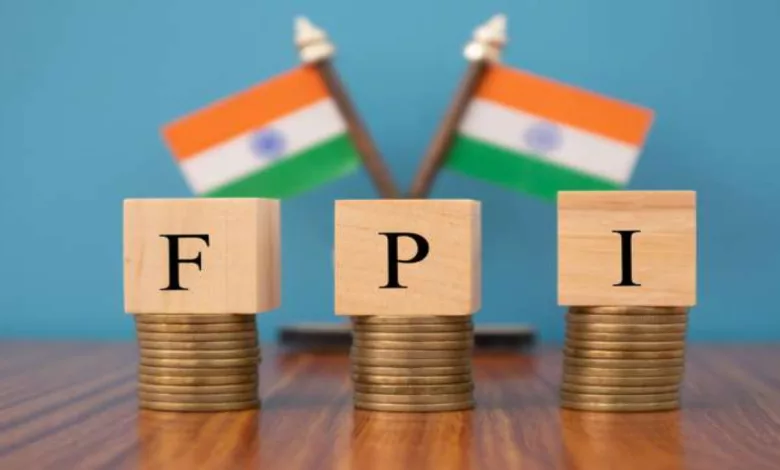So Far, FPIs Invested Rs. 7,233 Crores In Indian Equities
The majority of stock markets around the world experienced a quick recovery, but macroeconomic sentiment remained erratic because of worries about the stability of the US and European banks.

Last month, foreign investors (FPI) invested a total of Rs 7,200 crore in Indian stocks, largely as a result of the sizeable investments made in Adani group companies by US-based GQG Partners. The US financial sector started to feel pressure after Silicon Valley Bank and Signature Bank failed earlier this month. The majority of stock markets around the world experienced a quick recovery, but macroeconomic sentiment remained erratic because of worries about the stability of the US and European banks.
Portfolios that are foreign raise volatility. More risk is the end effect. Diversifying the portfolio and generating a sizable return are the goals of investing in foreign markets. Investors anticipate great profits given the level of risk they are ready to take. Foreign portfolio investing is a common investment strategy today. Everyone, from private persons and corporations to governments, holds foreign portfolios “The Fed reiterated its confidence in the strength of the American banking sector while raising Fed Fund rates by 25 basis points. The FPI flow is anticipated to continue unstable given the Fed’s strict monetary policy.” Shrikant Chouhan, Head of Equity Research at Securities Ltd., made this statement (Retail).
As of March 25, foreign portfolio investors (FPIs) invested Rs 7,233 crore in Indian equities, according to depository statistics. This followed a net outflow of Rs. 28,852 crores in January and Rs. 5,294 crores in February. Earlier, data revealed that FPIs invested a net amount of Rs 11,119 crore in December. According to Vijayakumar, the March inflow includes GQG’s large investment of Rs 15,446 crore in four Adani stocks.
Apart from this, there is a strong selling undercurrent represented by FPI activity in the stock market. FPIs sold securities worth a total of Rs 26,913 crore in 2023. FPIs bought commodities in the following sectors: financial services, mining, metals, and energy. Nevertheless, they achieved a significant sell-off in IT stocks. According to Geojit Vijayakumar, foreign investment will primarily go into domestic sectors such as banking, capital goods, and automobiles in India. As valuations for both sectors have improved after recent declines, a reverse trend in favor of IT and pharma is expected in the near term, he noted.

Expansion Of FPI In India
A key factor in India’s economic expansion is the inflow of foreign investment. To streamline compliance requirements and create uniform guidelines for different categories of foreign investors, including Qualified Foreign Investors (QFIs), Sub-Accounts, and Foreign Institutional Investors (FIIs), these investors have been merged into a new class of investors called Foreign Portfolio Investors (FPIs). The Foreign Portfolio Investors Regime will commence on 1 June 2014 by the SEBI Notification dated 7 January 2014 regarding the SEBI (Foreign Portfolio Investors) Rules, 2014.
To implement the Foreign Portfolio Investors (FPI) Regime, SEBI has granted Permission to NSDL to issue registration certificates on its behalf numbers and certificates of FPIs as well as track FPI group investments and display various statistics related to FPI operations on the NSDL website. Investment diversity is one of the advantages of foreign portfolio investments. Investors have the option to diversify their portfolios through FPI.
International credit
Investors can get more loans in foreign countries. They could expand their loan portfolio. Investors can secure their line of credit by increasing their credit base. Having a foreign credit score can be beneficial if your domestic credit score is unfavorable. This allows the investor to use more leverage and get big returns on their stock investments. Foreign markets can sometimes be less competitive than domestic markets. So FPI exposes you to a bigger market. Foreign markets can offer greater returns and greater variety because they are generally less saturated.

Enough liquidity
Foreign portfolio investments provide a large amount of liquidity. The investor can easily buy and sell foreign portfolios. This enables investors to take advantage of good buying opportunities as they present themselves. Investors can buy and sell trades with ease and speed.
Favorable exchange rate
The varying nature of different currencies can be advantageous for an investment. A strong currency can be advantageous to an investor because some currencies can move rapidly, increasing or dropping. Barring China, which saw inflows due to trade opening, FPIs were sellable in most emerging economies during the month. There were also net outflows from the Philippines, South Korea, Taiwan, and Thailand during the month under review, while there were inflows from India and Indonesia.
Despite growing fears of a resurgence of Covid-19 cases in various parts of the world, foreign investors invested Rs 11,119 crore in Indian stocks in December, the second consecutive monthly inflow. However, foreign portfolio investors (FPIs) have been more cautious recently.
Data from depositories showed that inflows in December were significantly lower than the Rs 36,239 crore invested by FPIs in November. Notwithstanding the market’s downturn, escalating worries about a Covid comeback in various parts of the world, and worries about a US recession. According to Himanshu Srivastava, Associate Director Of Research at Morningstar India, “FPIs continued to be net purchasers in Indian equities markets in December.” With Indian markets hitting all-time highs recently, many investors may have decided to book profits amid the lingering uncertainty.
FPIs withdrew a total of Rs. 1.21 lakh crore from Indian equity markets in 2022 due to aggressive rate hikes by central banks across the world, especially the US Federal Reserve, volatile oil prices, rising commodity prices, and conflict in Russia and Ukraine. In terms of flow, it has been the worst year for FPIs and their exit from the stock market follows three years of net investment.

Before these investments, there was an outflow of Rs 33,014 crore in 2019. According to VK Vijayakumar, chief investment strategist at Geojit Financial Services, the US interest rate hike, and Indian rupee depreciation will be the main drivers of net FPI selling in 2022. “After its recent high of 114, the dollar index has fallen below 104. FPIs are expected to become buyers in India in 2023 if this trend continues,” he added.
According to Morningstar India, FPIs would continue to invest in Indian equities in the short to medium term, albeit cautiously. Sanjiv Bajaj, Jt. Chairman and MD of Bajaj Capital said various variables, including the policy stance of the US Federal Reserve, movements in oil prices, and changes in the geopolitical scenario, will determine FPI flows.
In contrast, foreign investors withdrew a net amount of Rs 1,673 crore from debt markets in December, taking the annual outflow to Rs 15,911 crore. Debt markets then saw a net withdrawal of Rs. 10,359 crores in 2021 and Rs. 1.05 lakh crore in 2020. Due to uncertainty on the equity side, FPIs have used the debt segment for parking investments in the short term. To stem outflows from the debt market, they continued to make sporadic acquisitions, says Morningstar India’s Srivastava.
FPI flows in 2022
Foreign portfolio investor (FPI) capital flows in 2022 show two separate trends: after an aggressive sell-off in the first half of the year, they returned to Indian markets in the second half of the year. In the first half of 2022, FPIs sold $2.32 billion worth of Indian stocks and bonds, with the sell-off starting in October 2021 as foreign investors thought the US Federal Reserve would begin a quantitative tightening cycle. Until June of this year, when the US Fed raised interest rates three times, the sell-off persisted before a reversal began.
“Since July 2022, FPI flows have started to turn primarily positive, with brief periods of moderate selling towards India and other emerging markets. According to an ICICI Securities report, the above behavior could once again signal that the US Fed’s aggressive rate hikes may reach their peak. FPI flows accelerated as US Fed continues to hike interest rates; between July and November, Indian stocks and bonds saw a net investment of 92,763 crores from FPIs, according to NSDL statistics.
Hitesh Jain, the chief institutional equities analyst at Yes Securities, says the turnaround is a result of investment leaving Russia due to its conflict with Ukraine and moving to India. “The track record is clear when it comes to India’s credit growth and consumer spending.”

The financial services industry alone accounted for $14,205 million of the $36,238 million in net equity investment made in November. This indicates that FPIs are actively investing in sectors such as financial services. Of the 53.98 lakh crore total assets under management (AUC) owned by FPIs at the end of November, 16.35 lakh crore were assets in the equity and debt division. With FPIs already withdrawing $1.39 million, their net investment in Indian equities and bonds remains negative for the year.
The Nifty50 and Sensex have seen significant gains since the start of July, gaining a combined 18%, making them two of the best performers among the world’s major indices. Experts predict that FPI flows may gradually moderate in the future. According to Priyanka Sachdev, an analyst at Phillip Nova, “In 2023, Indian equity growth may face a small setback as foreign portfolio investment flows could reduce significantly for India and migrate to China instead as hopes of a full reopening of the economy post-Covid.”
Edited by Prakriti Arora




